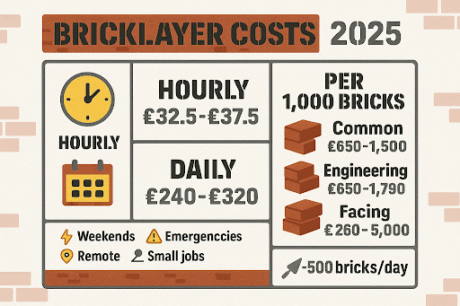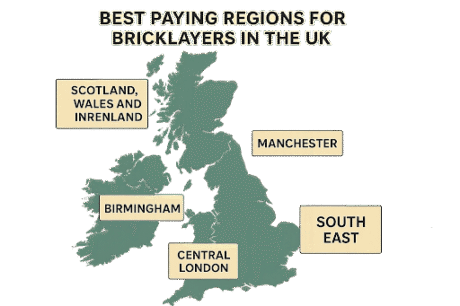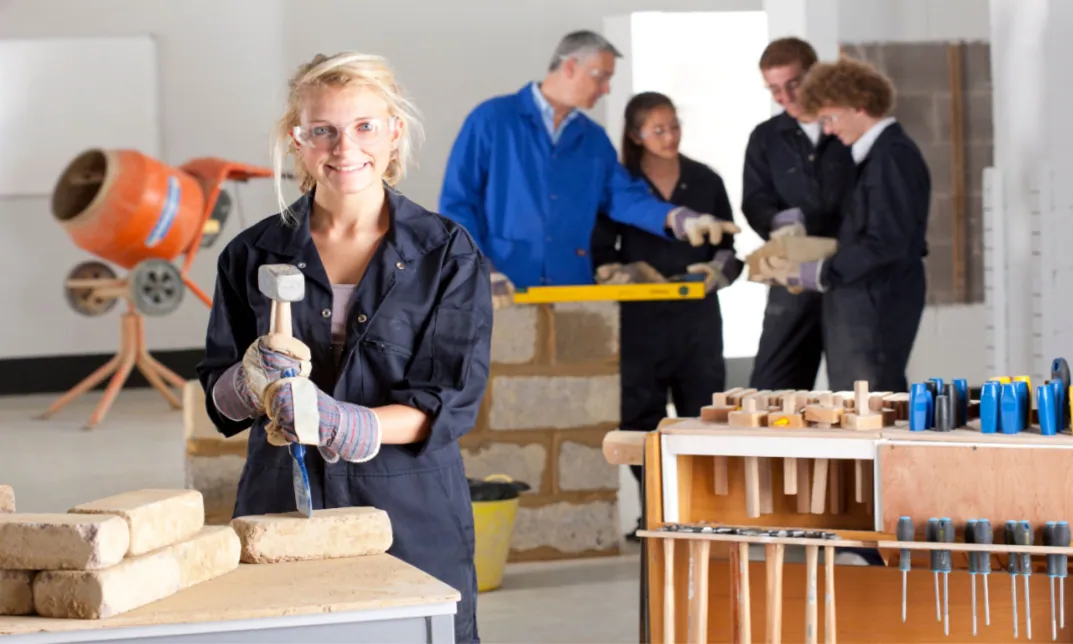No products in the cart.
How much do bricklayers get paid per brick in the UK? In 2025, experienced bricklayers often charge £32.50 to £37.50 per hour, or £240 to £320 per day. That’s for fast, high-quality work on typical building sites. These figures reflect current market rates in areas outside central London.
But that’s not the whole picture.
While some work by the hour or day, others earn a bricklayer per brick rate. On price work, skilled bricklayers can make £0.50 to £1 per brick, depending on the project, location, and speed.
Typical, employed roles pay between £25,000 and £45,000 a year, depending on experience. However, self-employed bricklayer earnings can exceed £56,000 annually for those in high demand. If you’re just starting out, the apprentice bricklayer wage is lower but still competitive, with room to grow as skills improve .The National Careers Service all offer up-to-date pay data.
Bricklayer Costs Explained
When it comes to costs and pricing, different jobs call for different methods. Domestic work often suits a bricklayer day rate or bricklayer hourly rate.
However, for bigger projects with repeat patterns, many prefer a bricklayer per brick rate. This works well when walls are long, clean, and consistent.
Use hourly rates when the job may change or has uncertain tasks. Use per-brick pricing when the work is straightforward and speed matters.
What Bricklayers Charge in 2025
Here’s a quick look at what bricklayers get paid:
- Hourly rate: £32.50 to £37.50
- Day rate: £240 to £320
- Per 1,000 bricks laid:
- Common bricks: £650 to £1,500
- Engineering bricks: £650 to £1,790
- Facing bricks: £2,260 to £5,000 (these take more time and care)
These rates come from Checkatrade’s 2025 figures.
Additionally, expect higher fees for:
- Weekend or evening jobs
- Emergency call-outs
- Remote locations
- Small jobs (often have a minimum charge)

On average, a bricklayer can lay around 500 bricks per day on a simple job. This makes the how much do bricklayers get paid per brick question easier to estimate on real projects
Pay by Experience: How Bricklayer Earnings Grow
Bricklayer pay rises as your skills and responsibility increase. Here’s a quick guide.
Apprentice Bricklayer
- What you earn: Most apprentices make about £11,000 a year. Day rates usually start around £60.
- What changes: You learn on site, building speed and safe habits.
Newly Qualified Bricklayer
- What you earn: Expect about £18 per hour and £145 per day.
- What changes: You work alone on simple jobs and start quoting for small projects.
Experienced Bricklayer
- What you earn: Typical rates are £32.50 to £37.50 per hour and £260 to £320 per day.
- What changes: You work faster, with fewer snags. You manage labour and materials well.
Foreman or Site Supervisor
- What you earn: A working foreman earns around £22 per hour or about £41,000 a year.
- What changes: You plan work sequences and manage quality, safety, and crews.
Business Owner
- What you earn: Day rates often sit between £304 and £320. A strong work pipeline increases yearly income.
- What changes: You get good at quoting, scheduling, and managing cash flow.
Rate Boosters
NVQ Level 2 or 3 qualifications, heritage skills, and site tickets (like a CSCS card) help you earn more. These prove your trustworthiness and skill.
Employed vs Self-Employed Bricklayers
- Employed: You get steady hours, holiday pay, and support. You accept a bit less pay for stability.
- Self-employed: You control your prices, schedule, and clients. But you pay for your own tools, van, fuel, insurance, software, accountant, PPE, and training.
Three Quick Income Scenarios for Self-Employed Bricklayers
- Lean year: Gaps in work hurt cash flow. You protect profit by setting minimum charges.
- Typical year: A solid work pipeline covers your overheads and tools.
- Busy year: Full weeks and upselling increase your income.
Public liability insurance usually costs about £100–£120 a year.
Best Paying Regions for Bricklayers in the UK

If you want to know how much do bricklayers get paid per brick or by the hour, location matters a lot. London and the South East usually pay bricklayers more than other regions. This higher pay reflects the cost of living, which is also much higher in these areas. So, while the rates are better, bricklayers face bigger expenses too.
Central London
Central London stands out with the highest day rates. Bricklayers often work on complex building sites here, which pay more. However, jobs can take longer because of extra travel and the need for permits. These factors sometimes reduce overall earnings despite the higher rates.
Birmingham
Moving outside London, Birmingham offers solid demand for bricklayers. The steady flow of new-build projects means pay stays consistent. Many bricklayers find good opportunities in this city, where the housing market keeps growing.
Manchester
In Manchester, regeneration projects and a booming housing market create strong pipelines of work. Bricklayers in this region benefit from plenty of jobs and competitive pay. The ongoing development helps keep earnings healthy.
Scotland, Wales, and Northern Ireland
When it comes to Scotland, Wales, and Northern Ireland, rates vary more. Pay depends heavily on which city you work in and how easy it is to find work. Some cities offer good rates, while others might pay less. Access to jobs also plays a big role in earnings here.
Looking at the big picture, regional earnings data consistently shows London at the top for bricklayer salaries. Whether you’re paid per brick, by the hour, or day, London usually leads the way. This fact makes it an attractive place for skilled bricklayers, especially those with NVQ Level 2/3 qualifications and a valid CSCS card.
Work Types That Pay Bricklayers More
Different types of bricklaying jobs pay differently. Knowing which work pays better can help you earn more.
- Domestic jobs include extensions, garden walls, and chimneys. These projects often pay less because access can slow down the work. Getting materials and tools in and out takes time.
- New-build projects usually pay better. Because the work is repetitive, bricklayers can work faster. This speed helps improve profit margins. Many bricklayers with NVQ Level 2 or 3 qualifications prefer new builds for steady pay.
- Commercial work often has tighter specifications and complex logistics. This means the pay rate can be higher. Bricklayers must follow strict rules and schedules, which can raise the day rate.
- Heritage work pays the most. Restoration masonry, lime work, and fine tolerances demand high skill. Bricklayers who master these areas can charge premium rates. Complex bonds, patterns, arches, mortar types, and strict tolerances also push prices up.
Hard site conditions, like poor access, scaffold lifts, and waste handling, add extra time. These factors increase costs and can raise how much bricklayers get paid per brick or per hour.
Skills That Boost Bricklayer Pay
Certain skills help bricklayers earn more money. These specialised skills show clients you deliver quality work.
Heritage and restoration masonry pay well. Clients often pay extra for lime mortars and work that meets conservation standards. Having NVQ Level 2 or 3 qualifications proves you can handle these delicate jobs.
(Source: nhbc.co.uk)
Eco-friendly bricklaying methods also boost earnings. Using low-carbon materials and managing waste carefully attract public contracts and eco-conscious clients. These projects often pay better and build a good reputation.
Custom and decorative masonry work rewards precision. Creating arches, patterns, and bespoke features shows craftsmanship. These tasks take skill, and clients are willing to pay more for the extra care and detail.
Ways for Bricklayers to Earn More

If you want to increase your bricklayer salary UK or improve your bricklayer day rate, try these tips.
- Pricing: Always set a minimum charge for jobs. Make sure you define a clear scope of work and rules for any extra changes. Adding a fair travel surcharge helps cover time and costs.
- Utilisation: Plan your work around the weather. Mix longer projects with quick jobs to keep your weeks balanced and busy.
- Lead Generation: Collect reviews from happy clients. Share photos and videos of your work online. Build your local SEO and join trusted directories to get more leads.
- Upsells: Offer extra services like repointing, fitting lintels, building steps, or premium call-outs. These add value and increase your earnings.
- Money Operations: Take deposits before starting work. Use staged payments for bigger jobs. Try a simple job management tool to keep track of quotes and invoices.
Employed vs Self-Employed Bricklayers
How much does a bricklayer earn can vary based on employment status:
- Employed: You get steady hours, holiday pay, and support. You accept a bit less pay for stability.
- Self-employed: You control your prices, schedule, and clients. But you pay for your own tools, van, fuel, insurance, software, accountant, PPE, and training.
Training and Cards for Bricklayers
To improve your bricklayer salary UK or bricklayer day rate, good training is key. There are three main routes: college courses (Level 1, 2, and 3), apprenticeships, and learning on site. Most construction sites ask for a valid CSCS card. You may use the official CSCS Card Finder to pick the right card for your role.
Achieving NVQ Level 2 lets you get the Blue Skilled Worker card, that is essential for most site work. You build speed and confidence faster by working regularly on site and getting mentoring from experienced bricklayers.
Tools and Costs for Bricklayers
To grow your bricklayer salary UK, you need the right tools. Every bricklayer should have hand tools, a mixer, levels or a laser, PPE, and a van or other transport. Simple job software also helps track work and payments.
Public liability insurance protects you on client sites. It’s a must for self-employed bricklayer earnings and usually costs £100–£120 per year.
A Realistic Starter Range (Excluding Van)
- A basic tool kit costs a few hundred pounds. You can find trade bundles that keep it affordable.
- A mixer costs about £579.
- Liability insurance adds £100–£120 to your setup.
- A mid-range setup (with better PPE, tools, and software) lands in the low thousands.
- A high-end setup—with premium tools, marketing, training, and a top mixer—sits in the several-thousand-pound range.
Don’t forget: tools wear out. Budget for maintenance and replacements across the year.
CPD Courses
CPD stands for Continuing Professional Development. These short courses help bricklayers grow their skills and stay in line with modern site standards. They’re great for both employed and self-employed bricklayers who want to stay competitive.
CPD often covers in-demand areas like heritage work, eco-friendly bricklaying, and decorative masonry. These are specialist skills that boost your value on site. Learning how to use lime mortars, create custom patterns, or reduce waste helps you charge more and stand out from other trades.
Job readiness
Taking CPD shows employers and clients that you work safely, understand new materials, and follow the latest building rules. This is a big plus when applying for jobs or quoting for private work. Many sites now expect bricklayers to stay updated through regular training.
Ongoing learning
Some employers ask for a record of CPD hours. This proves you’re serious about growth and quality. Even if you’re self-employed, CPD helps you build a stronger reputation, win better jobs, and grow your bricklayer salary UK over time.
FAQs
- How much do bricklayers get paid per brick in the UK?
Most bricklayers earn 650 and £1,790 per 1,000 bricks, depending on the job and location.
- How many bricks can a bricklayer lay each day?
If you need a day rate, a two-man bricklaying team typically costs between £350 and £550 per day. A skilled and experienced bricklayer can usually lay 500 to 800 bricks per day, depending on the job.
- Do NVQ Level 2 or CSCS cards help with pay?
Yes. They prove your skills and help you get better pay and site jobs.
- What CSCS card do I need for bricklaying?
Skilled bricklayers may apply for the Blue CSCS card but they will need to hold a relevant NVQ/SVQ Level 2 qualification in order to do so.
- How much to charge to lay brick?
Brick walls typically cost $10–$45 per square foot, with labor ranging from $70–$110 per hour. Concrete block walls are cheaper, at around $10–$20 per square foot, and usually involve less labor and lower costs.
Build Your Future
Ready to progress? Our Bricklaying Training Course helps you get qualified, gain practical skills, and improve your pay. Join now to build a strong, rewarding career!







